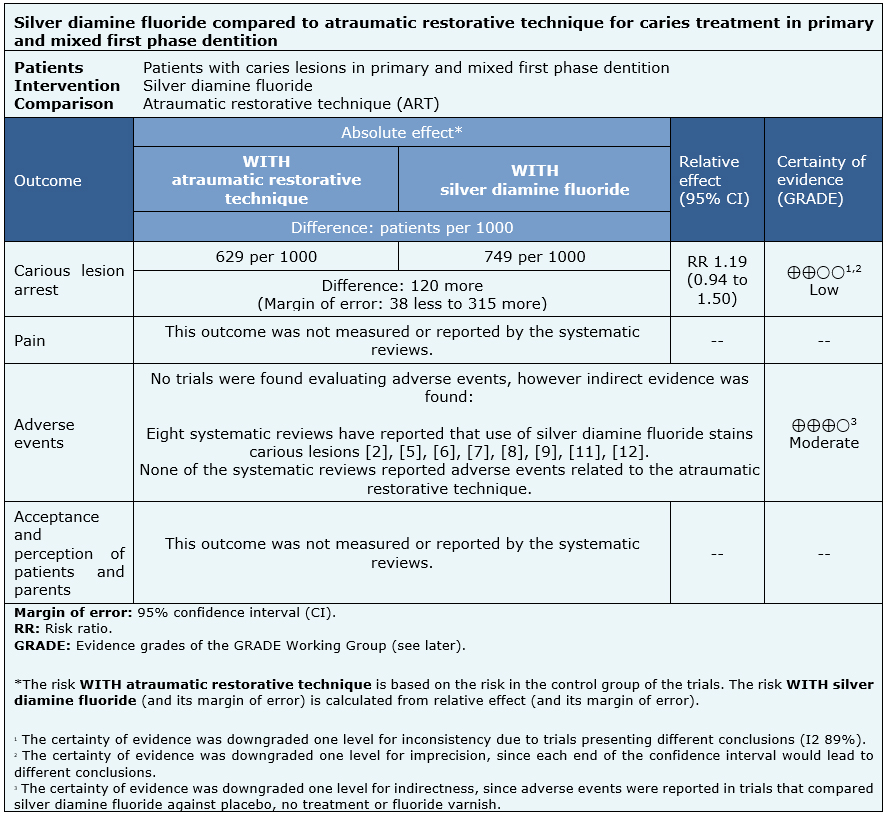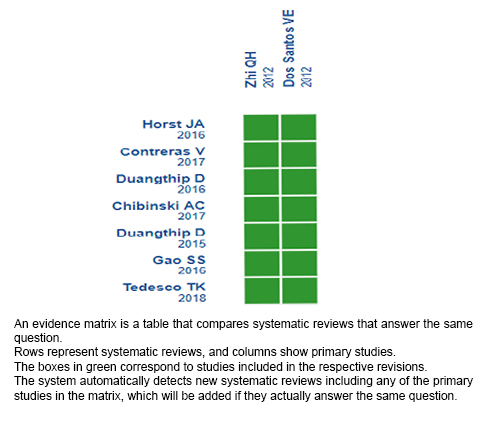Epistemonikos summaries
← vista completaPublished on August 25, 2020 | http://doi.org/10.5867/medwave.2020.07.8002
Silver diamine fluoride compared to atraumatic restorative technique for the treatment of caries in primary and mixed first phase dentition
Fluoruro diamino de plata comparado con técnica de restauración atraumática para el tratamiento de caries cavitadas en dentición primaria y mixta primera fase
Abstract
INTRODUCTION Cavitated carious lesions in primary and mixed dentition require prompt treatment to control caries progression. Silver diamine fluoride has emerged as an alternative to the atraumatic restorative technique due to its easy application. However, there is still uncertainty regarding its effectiveness and safety.
METHODS We searched in Epistemonikos, the largest database of systematic reviews in health, which is maintained by screening multiple information sources, including MEDLINE, EMBASE, Cochrane, among others. We extracted data from the systematic reviews, reanalyzed data of primary studies, conducted a metanalysis and generated a summary of findings table using the GRADE approach.
RESULTS AND CONCLUSIONS We identified ten systematic reviews, including two studies overall, which are randomized trials. We concluded that silver diamine fluoride compared to the atraumatic restorative technique may increase the arrest of caries in primary and mixed first phase dentition, however, the certainty of the evidence has been assessed as low. On the other hand, treatment with silver diamine fluoride compared to the atraumatic restorative technique (ART) probably increases the risk of adverse events.
Problem
The worldwide prevalence of caries in children under 5 and 6 years old varies between 49% and 64.4% according to data from the World Health Organization [1]. Dental caries affects general health, having a negative impact on growth, quality of life and cognitive development, besides oral health [2].To treat cavitated carious lesions, the atraumatic restorative technique (ART), is not always feasible to perform due to its complexity, material resources required, and behavior management of the pediatric patient. Silver diamine fluoride has emerged as an alternative to atraumatic restorative technique since it inhibits cariogenic biofilm formation and generates a highly remineralized dentin surface, rich in calcium and phosphate ions [3], [4]. Among the silver diamine fluoride benefits, its non-invasive features characterized by a simple application technique stands out, therefore, it appears to be a promising treatment for young children, patients with bad behavior or special needs. However, there is still uncertainty regarding its effectiveness and safety.
Methods
We searched in Epistemonikos, the largest database of systematic reviews in health, which is maintained by screening multiple information sources, including MEDLINE, EMBASE, Cochrane, among others, to identify systematic reviews and their included primary studies. We extracted data from the identified reviews and reanalyzed data from primary studies included in those reviews. With this information, we generated a structured summary denominated FRISBEE (Friendly Summary of Body of Evidence using Epistemonikos) using a pre-established format, which includes key messages, a summary of the body of evidence (presented as an evidence matrix in Epistemonikos), meta-analysis of the total of studies when it is possible, a summary of findings table following the GRADE approach and a table of other considerations for decision-making.
|
Key messages
|
About the body of evidence for this question
|
What is the evidence. |
We identified ten systematic reviews [2], [5], [6], [7], [8], [9], [10], [11], [12], [13] including two studies overall [14], [15] , of which both were randomized trials. The table and summary in general are based on the latter. |
|
What types of patients were included* |
Both trials included children (3 to 6 years) with primary and mixed first phase dentition, with cavitated caries lesions without pulp injury [14], [15]. |
|
What types of interventions were included* |
All trials evaluated the use of silver diamine fluoride compared to atraumatic restorative technique (ART). One trial [14] evaluated 38% silver diamine fluoride in two different application schemes: in one group was applied every six months, and in the second group every 12 months. The second trial [15], administered 30% silver diamine fluoride as a single dose. |
|
What types of outcomes |
The trials evaluated multiple outcomes, which were grouped by the systematic reviews as follows:
|
* Information about primary studies is not extracted directly from primary studies but from identified systematic reviews, unless otherwise stated.
Summary of findings
The information on the effects of silver diamine fluoride compared to the atraumatic restorative technique (ART) is based on two randomized clinical trials [14], [15]. One of them [14] included two groups that received silver diamine fluoride in different application doses, so they were considered separately. Both trials measured the arrest of caries lesions [14], [15] (303 patients, 953 teeth). No review allowed the extraction of data from adverse events for silver diamine fluoride or atraumatic restorative technique, so the information on this outcome is presented as a narrative synthesis. No systematic review measured pain or patient and parent acceptance and perception outcomes.
The summary of findings is as follows:
- Treatment with silver diamine fluoride compared with the atraumatic restorative technique could present a higher arrest of the carious lesions in primary and mixed first phase dentition (low certainty evidence).
- Treatment with silver diamine fluoride compared to the atraumatic restorative technique probably increases the risk of adverse events (moderate certainty evidence).
- No systematic reviews were found that looked at pain.
- No systematic reviews were found that looked at acceptance and perception of patients and parents.

| Follow the link to access the interactive version of this table (Interactive Summary of Findings – iSoF) |

Other considerations for decision-making
|
To whom this evidence does and does not apply |
|
| About the outcomes included in this summary |
|
| Balance between benefits and risks, and certainty of the evidence |
|
| Resource considerations |
|
| What would patients and their doctors think about this intervention |
|
|
Differences between this summary and other sources |
|
| Could this evidence change in the future? |
|
How we conducted this summary
Using automated and collaborative means, we compiled all the relevant evidence for the question of interest and we present it as a matrix of evidence.

Follow the link to access the interactive version: Silver diamine fluoride compared to atraumatic restorative technique for the treatment of caries in primary and mixed first phase dentition.
Notes
The upper portion of the matrix of evidence will display a warning of “new evidence” if new systematic reviews are published after the publication of this summary. Even though the project considers the periodical update of these summaries, users are invited to comment in Medwave or to contact the authors through email if they find new evidence and the summary should be updated earlier.
After creating an account in Epistemonikos, users will be able to save the matrixes and to receive automated notifications any time new evidence potentially relevant for the question appears.
This article is part of the Epistemonikos Evidence Synthesis project. It is elaborated with a pre-established methodology, following rigorous methodological standards and internal peer review process. Each of these articles corresponds to a summary, denominated FRISBEE (Friendly Summary of Body of Evidence using Epistemonikos), whose main objective is to synthesize the body of evidence for a specific question, with a friendly format to clinical professionals. Its main resources are based on the evidence matrix of Epistemonikos and analysis of results using GRADE methodology. Further details of the methods for developing this FRISBEE are described here (http://dx.doi.org/10.5867/medwave.2014.06.5997)
Epistemonikos foundation is a non-for-profit organization aiming to bring information closer to health decision-makers with technology. Its main development is Epistemonikos database (www.epistemonikos.org).
Potential conflicts of interest
The authors do not have relevant interests to declare.

